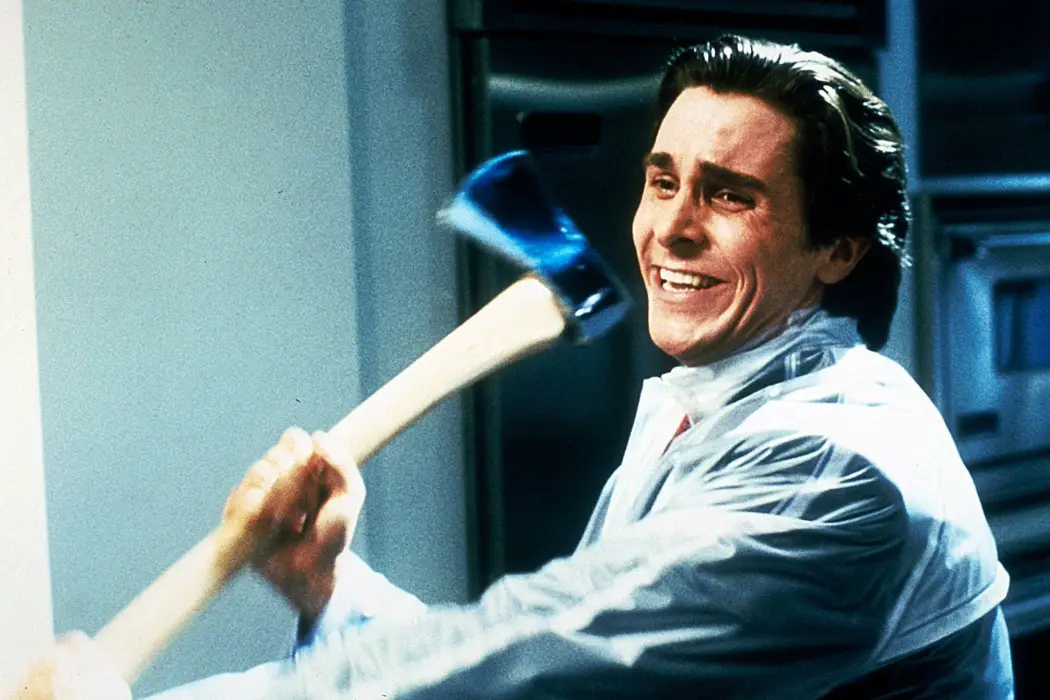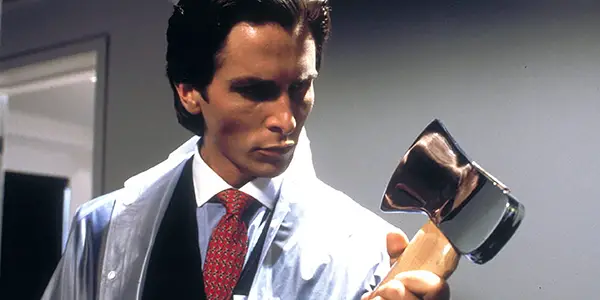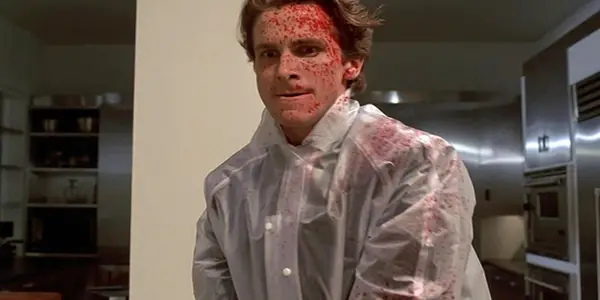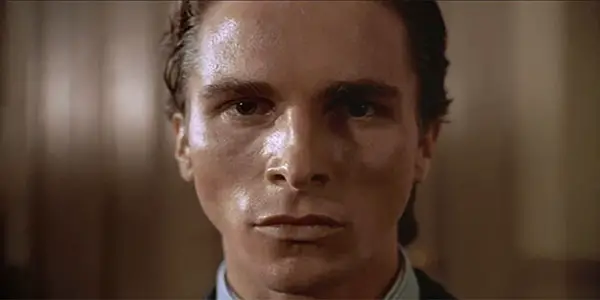The Madness Of Patrick Bateman: How AMERICAN PSYCHO Redefined The Horror Villain

Liam is a freelance culture writer based in London.
American Psycho’s Patrick Bateman is one of the most insane horror movie creations of all time. At once despicable and entirely engaging, his bursts of extreme violence still shock twenty years later. Patrick Bateman is an empty shell, a ghost in a machine, and after hours, he can be found swinging an axe or rampaging the corridors of his apartment building, smeared in blood, and wielding a chainsaw. Bateman’s villainy has an unkempt coldness, a tinge of the surreal and his actions cut deep into the recesses of our nightmares.
All of this is grounded by Christian Bale’s star-making performance. When Bale was cast in American Psycho, he was a relatively unknown actor, but his role as the psychopathic Patrick Bateman was a work of genius and confirmed his position as one of the elites in Hollywood. Based on Bret Easton Ellis’ controversial novel, American Psycho is a masterpiece of satire, offering a chilling look into yuppie culture during the ’80s. In the hands of another director, American Psycho could have easily been exploitative, but Mary Harron managed to create an exceptional cult movie that provides a sharp critique of a bygone era while bringing to life a different kind of villain.
An Enduring Villain
The character of Patrick Bateman epitomises the modern-day movie monster. Unlike traditional horror villains, there is nothing supernatural about Bateman. At first glance, he’s a charming and affluent Wall Street stockbroker, but beneath the surface lies a tortured existence. His personality is a fabrication, carefully constructed to fit in with his co-workers and to blend into society. “I have all the characteristics of a human being: flesh, blood, skin, hair, but not a single clear identifiable emotion except for greed and disgust,” he says in a voice-over. There’s a haunting sense of loss and foreboding about Bateman’s telling, and his failure to recognise his emotional state makes him all the more volatile.

American Psycho provides a complex portrayal of a character who’s a product of his consumer culture, and who details virtually every feature of his daily routine. Early on in the film, Patrick Bateman says, “I am simply not there.” This is because he is indistinguishable among the other investment bankers in Wall Street, and it’s his wealthy lifestyle, which can be seen through his business cards and lavish dinner reservations, that draws in his victims.
Bateman gets away with his crimes because he acts like everybody else, to the point that his peers mistake him for other people. He’s well in the confines of his yuppie stereotype, yet simultaneously, he cannot be contained. Bateman lives a double life and as a villain, he embodies absolute autonomy in the darkest possible sense. He drifts through society, unnoticed, unhinged and rampant. Duping others with his charm and intelligence, Patrick Bateman slips his desires and fantasies into everyday conversations, which are always misheard or taken as a joke. American Psycho then, suggests that monsters can be anywhere, even with normal appearances like Bateman’s.
American Psychos
Psycho killers reign supreme in the world of horror and Patrick Bateman stands out as a monster with his own unique agenda. He’s driven by a warped self-righteousness and there’s a tragic irony in the core of his character because he knows that he’s insane. In many respects, Patrick Bateman is a re-imaging of movie monsters that have come before him, like Leatherface from The Texas Chainsaw Massacre, who’s a huge, hulking figure, wearing a mask. The differences in American Psycho and traditional “slashers” is what makes the film all the more fascinating. Compared to the likes of Wes Craven’s Scream, there’s much to be said about how American Psycho subverts narrative conventions. In most slasher films, the identity of the killer is revealed at the end, but in American Psycho, the protagonist is the killer himself with the film told from his point of view. And traditionally, movie monsters reflect the fears of the unknown, but the anxieties behind American Psycho are that of greed, desire and repression.

American Psycho centres around the idea that monstrosity can bubble under the surface, evidenced when Bateman states, “Something horrible is happening inside of me and I don’t know why.” Through mixing Bateman’s mundane daily activities with his brutal murders, American Psycho disturbingly parallels the normality of everyday life with that of the homicides of a psychopath. It could also be seen that American Psycho reflects anxieties around repression through normality, and the fear of giving in to one’s desires, however horrifying they might be.
As Bateman, Bale portrays just the right kind of lunacy that it’s hard not to have conflicting reactions toward the character. Tasha Robinson wrote a piece about American Psycho for The Dissolve several years ago, arguing that Bateman could be seen as a sympathetic figure, an opinion that I believe still holds up. As she put it, “As vapid, malicious, and angry as he is, there’s a core of something human in him, something that has mercy on Jean when they’re alone together, something that’s scared and discomfited when an associate mistakes his murderous advances for amorous ones.” It’s a reading not everybody will agree with. There are, however, poignant moments in the film that remind viewers that Patrick Bateman isn’t a mastermind, but instead, acting out of compulsion, while trying to navigate the chaos of his life, and that’s part of the reason why he’s such a complex villain.
Mask of Sanity
As Patrick Bateman descends further into insanity, his actions and the very nature of his identity, are called into question. Who is Patrick Bateman? What does he stand for? And are these killings just all in his head? American Psycho’s blurring of reality and fantasy drives the central message that Bateman’s place in society lacks meaning, which extends to pretty much every other character in the film. They all seem to have a rather hollow existence, serving to further the film’s idea of a world where everyone is disconnected from reality. Even as Patrick Bateman presents himself as part of the normal, there’s always a mad psychosis hanging over him, waiting to implode, making it impossible to discern between the real and the imagined.

In the climax of many horror movies, the monsters are exposed for what they really are, but in American Psycho, there’s nothing to be discovered. The audience already knows Patrick Bateman’s dark secret, so when his “mask of sanity” begins to slip, we experience the threat of being caught, alongside Patrick Bateman, giving the feeling that we too have committed the crimes. Now, there are plenty of other films where the audience is made to emphasise with the villain, such as in The Silence of The Lambs, but where American Psycho differs to many of its contemporaries, is in how it avoids giving viewers a complete picture of Patrick Bateman. Instead, American Psycho uses the character to satirise the excess of greed and corporate culture.
And that begs the question of whether the true horror of American Pyscho lies in how society has become self-absorbed. Is Patrick Bateman simply a pawn in a much bigger terror? What’s brilliant about Bale’s portrayal of Bateman is that he’s able to elicit so much ambiguity without losing the fear-factor, and the character’s yuppie persona, all of which makes Patrick Bateman a singularly defined villain and subversive force in horror.
Final Thoughts
Patrick Bateman is a movie monster, redefined for a contemporary audience. He’s a monster in designer suits, lost in the void of consumerism, and viewers aren’t compelled to understand him, because he barely understands himself. He’s a villain that simply exists. To this end, Patrick Bateman represents the horrors of addiction, hedonism, narcissism and greed – and with a dose of humour, he’s a character that remains ingrained in our pop culture landscape.
What do you think of American Psycho? Who’s your favourite horror villain? Let us know in the comments!
Watch American Psycho
Does content like this matter to you?
Become a Member and support film journalism. Unlock access to all of Film Inquiry`s great articles. Join a community of like-minded readers who are passionate about cinema - get access to our private members Network, give back to independent filmmakers, and more.













